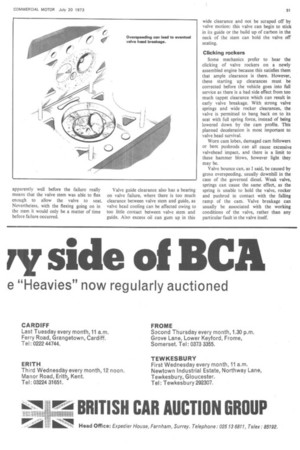road and workshop by Handyman
Page 52

Page 53

If you've noticed an error in this article please click here to report it so we can fix it.
Avoid engine overspeed ing at all costs
Regular valve gear maintenance is of paramount importance to avoid valve damage: too much valve guide clearance or misalignment are major causes of valve breakage.
HAVOC occurs when a diesel engine valve head breaks off at speed because space is very limited inside the combustion chamber and there is just nowhere for it to go once it is parted from its stem.
Invariably the loose valve head will be thrown on to its edge, and in that position is pile driven up to the cylinder head by the piston; the piston usually comes off far worse than the cylinder head, which just might be recoverable. But down the bore the piston damage can be serious, and conveyed to cylinder and block, and block change is not unknown where the piston has split and expanded. Why does the valve head break off? Two reasons are two fairly obvious, and one or two others not so clear. First, valve timing can slip owing to a sheered key or faulty chain tensioner. However, it is rare for just one valve to suffer as usually they all receive a belting in turn, and several pushrods or rocker levers can be bent as well.
Overrun The second reason can be that the vehicle has been overrun downhill far over its governed rpm, and a tired valve spring allows a single valve to be caught by its piston, so that the stem is bent and the valve head thrown off line with its seating.
There are, however, other reasons for valve breakages. The trouble can start right after new valve inserts have been fitted, as if the interference or press-fit load has been too great, the hardened seat can peel metal from the cylinder head as it is pressed home. As this scraped off metal can prevent the seat from making a good contact with the counter bore, excessive heat can be generated which can either loosen the seat or crack it. In either event the seat will move and the valve is then liable to break shortly afterwards.
Bad mating of valve and seat during top overhaul can set up flexing in the valve stem, and dependent upon the amount of ill-mating will be the length of time the valve will work before fracture and failure. The fact that the engine was performing apparently well before the failure really means that the valve stem was able to flex enough to allow the valve to seat. Nevertheless, with the flexing going on in the stem it would only be a matter of time before failure occurred. Valve guide clearance also has a bearing on valve failure, where there is too much clearance between valve stem and guide, as valve head cooling can be affected owing to too little contact between valve stem and guide. Also excess oil can gum up in this wide clearance and not be scraped off by valve motion; this valve can begin to stick in its guide or the build up of carbon in the neck of the stem can hold the valve off seating.
Clicking rockers
Some mechanics prefer to hear the clicking of valve rockers on a newly assembled engine because this satisfies them that ample clearance is there. However, these starting up clearances must be corrected before the vehicle goes into full service as there is a bad side effect from too much tappet clearance which can result in early valve breakage. With strong valve springs and wide rocker clearances, the valve is permitted to bang back on to its seat with full spring force, instead of being lowered down by the cam profile. This planned deceleration is most important to valve head survival.
Worn cam lobes, damaged cam followers or bent pushrods can all cause excessive valvehead impact, and there is a limit to these hammer blows, however light they may be.
Valve bounce can, as I said, be caused by gross overspeeding, usually downhill in the case of the governed diesel. Weak valve, springs can cause the same effect, as the spring is unable to hold the valve, rocker and pushrod in contact with the falling ramp of the cam. Valve breakage can usually be associated with the working conditions of the valve, rather than any particular fault in the valve itself.




































































































